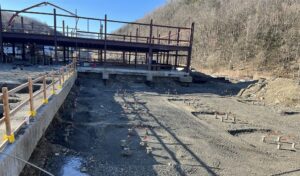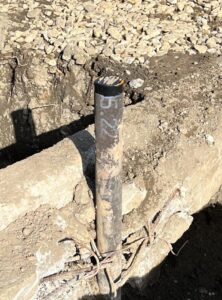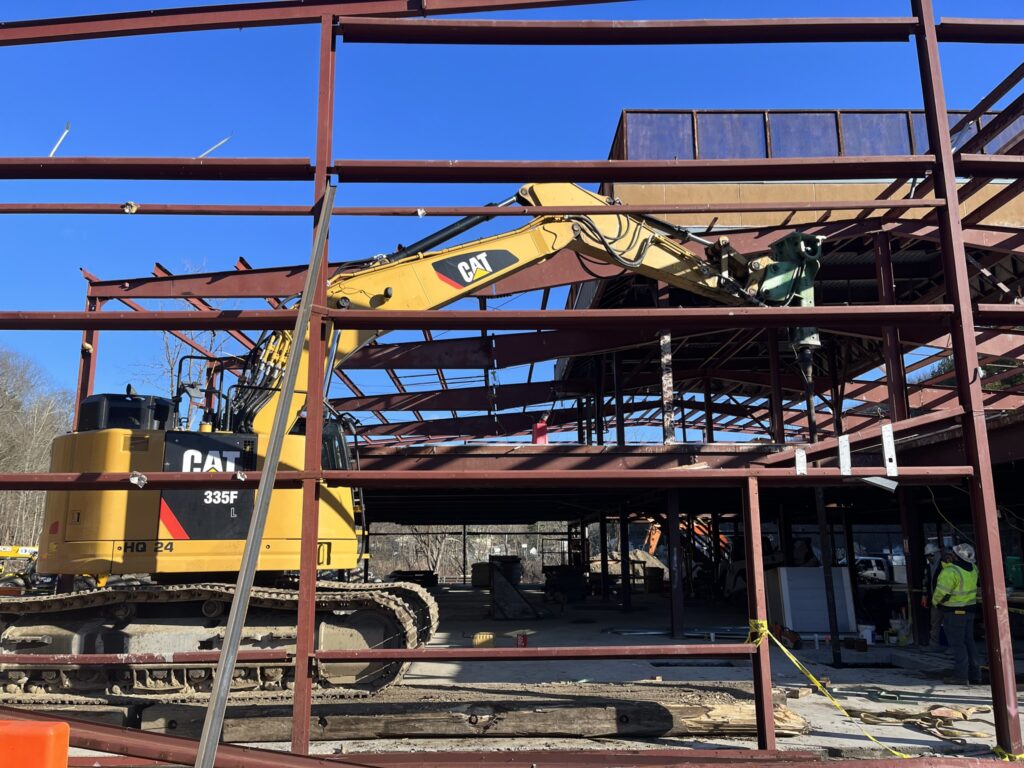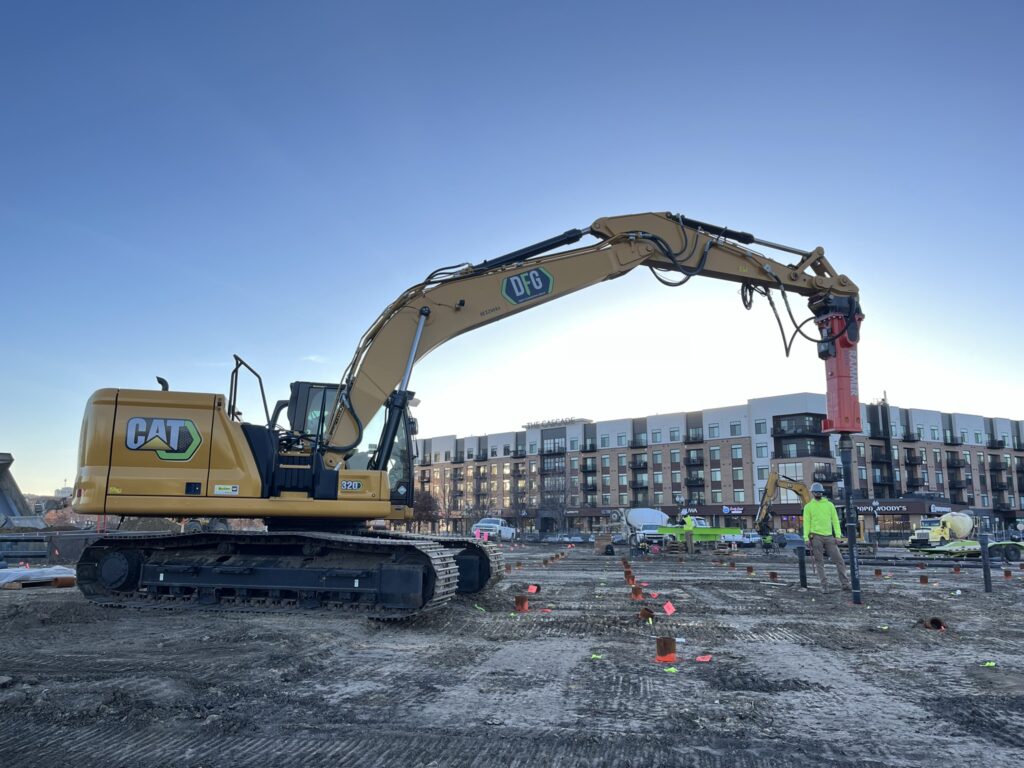Ductile Iron Piles provided a low vibration, cost-effective foundation solution capable of penetrating the urban fill and working within limited clearance (both overhead & access) within the existing building to support new foundations.
Project Description:
The project consists of renovating multi-story commercial buildings previously used for industrial purposes into luxury self-storage facilities. Design plans required demolition of portions of the existing industrial buildings to allow for new construction, while other portions of the existing buildings were gutted for re-use of the structural framing. Existing timber pile supported grade beams remained in place for reuse with modification. An additional building was also planned on-site which required completely new foundations.
Geotechnical Conditions:
Soil conditions along the banks of the Norwalk River included heterogeneous “urban” fill consisting of sand, gravel and silt as well as wood, metal, concrete, boulders and other materials extending up to 12 feet below grade. The fill was underlain by soft organic soils (peat, organic silt, sand with organics) extending up to 56 feet below grade. Glaciofluvial sand and gravel were then encountered to depths of 75 to 79 feet where borings terminated on bedrock.
Project Challenges:
Provide a low vibration, cost-effective foundation solution capable of penetrating the urban fill and working within limited clearance (both overhead and access) within the existing building to support new foundations.
Advantages
- Low vibrations
- Cost and schedule savings compared with micropiles and helical piles
- Ability to work on constrained sites and in restricted overhead
- Ability to penetrate through debris fill
- No depth limitations to easily manage varying rock depths
Design and Construction Solution
 Deep foundations for the project were originally planned to be a combination of helical piles and micropiles. Helical piles were planned for areas of the renovated grade beam foundations, while micropiles were proposed to ensure the ability to penetrate the debris-laden fill. With micropile estimates resulting in substantial foundation costs, alternative value-added foundation solutions were proposed by Helical Drilling, Inc. and considered by the project team. A low vibration Ductile Iron Pile solution was able to address constrained access and restricted overhead clearance in many locations. With the Plug and Drive connection, the Ductile Iron Pile option also allowed for rapid penetration to reach the bedrock at varying depths. This led to scheduling efficiencies and better than estimated production rates. In areas where debris obstructed the piles, plans called for shallow removal of the obstruction, offsetting of the piles, or replacement of the pile. In limited overhead areas (11 ft or less at this site), the alternative foundation solution maintained the use of micropiles. The alternative foundation solution was selected by the Contractor and Project Owner.
Deep foundations for the project were originally planned to be a combination of helical piles and micropiles. Helical piles were planned for areas of the renovated grade beam foundations, while micropiles were proposed to ensure the ability to penetrate the debris-laden fill. With micropile estimates resulting in substantial foundation costs, alternative value-added foundation solutions were proposed by Helical Drilling, Inc. and considered by the project team. A low vibration Ductile Iron Pile solution was able to address constrained access and restricted overhead clearance in many locations. With the Plug and Drive connection, the Ductile Iron Pile option also allowed for rapid penetration to reach the bedrock at varying depths. This led to scheduling efficiencies and better than estimated production rates. In areas where debris obstructed the piles, plans called for shallow removal of the obstruction, offsetting of the piles, or replacement of the pile. In limited overhead areas (11 ft or less at this site), the alternative foundation solution maintained the use of micropiles. The alternative foundation solution was selected by the Contractor and Project Owner.
A compression load test program was performed prior to the start of production work. The test pile consisted of a Series 118/7.5 Ductile Iron Pile (118 mm OD with 7.5 mm wall thickness). The pile was installed with a heavy-duty drive shoe and driven to depth with a Tramac V1800 hammer mounted on a CAT 335F excavator. The test pile penetrated the fill, organic soil and underlying sand and gravel to terminate on rock at a depth of 83 feet. The pile was driven to a set criteria of 1” or less in 50 seconds. The results of the load test showed a maximum design load of 75 kips after incorporating a 10-kip ultimate downdrag load. Deflection at the design load was approximately ½-inch.
 Installation of production piles followed the successful load test. Piles were installed to depths ranging from about 30 feet in the shallowest areas up to 108 feet in the locations approaching the river. While the speed of penetration through the debris fill varied, localized refusals seldom occurred with the pile installations. In fact, one pile was unknowingly, but successfully, driven through an existing buried grade beam with no damage to the pile. Pile installations continued across all buildings while the ongoing structural design progressed. Overall, a total of 403 production piles were installed to an average length of 70 feet. With the crew achieving production rates of over 1,800 LF/day at times, the piles were installed in only 36 days of driving. The decision to use Ductile Iron Piles in lieu of micropiles where practical resulted in an estimated savings of more than $1M and over 2 months in schedule.
Installation of production piles followed the successful load test. Piles were installed to depths ranging from about 30 feet in the shallowest areas up to 108 feet in the locations approaching the river. While the speed of penetration through the debris fill varied, localized refusals seldom occurred with the pile installations. In fact, one pile was unknowingly, but successfully, driven through an existing buried grade beam with no damage to the pile. Pile installations continued across all buildings while the ongoing structural design progressed. Overall, a total of 403 production piles were installed to an average length of 70 feet. With the crew achieving production rates of over 1,800 LF/day at times, the piles were installed in only 36 days of driving. The decision to use Ductile Iron Piles in lieu of micropiles where practical resulted in an estimated savings of more than $1M and over 2 months in schedule.
Project Team Members
DIP Design/Build Partner: Helical Drilling
Geotechnical Engineer: CLA Engineers, Inc.
General Contractor/Owner: Fletcher Development LLC
Structural Engineer: McCormack, Pelliccione & Associates, LLC







